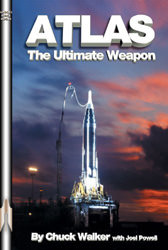
The Atlas booster evolved directly from the melding of experienced German rocket scientists with the need of the United States to counter the USSR’s ability. That is, the United States needed an Intercontinental Ballistic Missile (ICBM). However, as much as the German’s had successfully produced the V2 rocket, there was a huge jump in requirements from the V2 to their needs. For instance, a much heavier payload had to accurately and quickly fly much further over the Earth’s surface and land within a few miles of a given target. And this was to happen within minutes from activation. The Atlas booster was one of the industries’ responses to this government need and this history takes the reader through many of the trials, tribulations and interesting moments that occurred in this evolution of rocket technology.
The goal of the Atlas project was to have a number of active squadrons of ICBMs, ready in an instant to retaliate. Yet, their main goal was to deter an aggressor so they would truly succeed by remaining unused. In a few short years, Convair achieved this goal but the technological advances soon outdated the Atlas booster. Here is where Walker emphasises the beauty of the design as, even with this end point, the Atlas booster went on to perform stellar work in another arena, the space program. Using the tried and true technology of the Atlas booster, men were placed in orbit, cameras were sent to the moon and many global observatories were lofted up. That is, even after launching all the stored Atlas boosters, Convair kept producing these boosters to satisfy general space launch needs.
Using the perspective of a managerial level expert in this industrial program, which he was, Chuck Walker takes the reader on through the concept stage and up to the end of life for the primary mission. His history commences with the state of world affairs that generated a request for proposal by the United States’ Air Force. Convair, an aeroplane manufacturer dabbling in rocketry, won. Walker then uses his own experience within Convair, as well as recollections of many other managers together with saved documentation, to prepare a valid general review.
We read how estimates had to be made for launch site construction even though the missile design was not complete. Materials got stressed to the boundaries of knowledge and beyond. Configuration management, tracking change requests and obtaining appropriate authority ranged from casual recognition during the design stages to almost stifling bureaucracy during installation. Equally, the test and trials start with pure guess work but with experience, processes and procedures ably verified capability and ensured safety. This transformation from novice to proud and knowledgeable initiate resonates throughout the text.
In addition to the actual missile fabrication and deployment, Walker includes many direct contributions from relevant people regarding events and relations with other companies and subcontractors. These views come almost singularly from Convair managerial personnel so there is likely some bias in the perspective. Negligible reference is given to the contributions from subcontractors such as Rocketdyne and its rocket engines or General Electric and its guidance package. Interactions with the customer, that is the United States Air Force, continually crop up to put the pace and level of work into perspective. An overseer company, Ramo-Wooldridge, also has many references as it performed reviews and secondary checks often to the consternation of Convair managers. In all, many personal relationships, well remembered expos?s and a few choice scenarios pleasantly enliven the staid details normally associated with the histories of equipment.
As with any historical review, this book follows a chronological order. However, many particular quotes make the time line seem jumpy. That is, contributor often refer to events discussed in earlier chapters or covered further along in the text. Also, given that Walker refers to the Atlas as a workhorse of the space program, there could have been more information on its usage as such, for example to discuss significant upgrades and accomplishments. Still, there are references for those wishing to explore further.
An Atlas booster put John Glenn into orbit, Surveyor-1 on the Moon and Pioneer-11 to Saturn. But, it began as a critical element in the United States’ policy of deterrence in the early 1960s when rocketry was still in its infancy. The book “Atlas The Ultimate Weapon” by Chuck Walker, with Joel Powell, writes up the history of the development of this weapon and in so doing describes the challenges in mass producing a state of the art ballistic rocket.
Order a copy online from Countdown Creations.
Review by Mark Mortimer.
